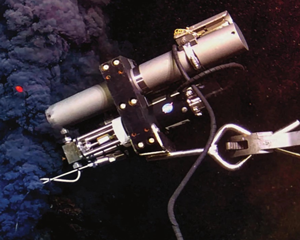Two days after arriving at the Aurora seamount, NUI dived to Aurora.
抵達奧洛拉海底山兩天后,NUI下潛至海底熱泉區。
As the orange sub sank in the long Arctic twilight, a gentle snow fell on fields of frost flowers carpeting the ice.
當這艘橙色的潛水器在北極漫長的暮色中下沉時,一場輕柔的雪落在了覆蓋著霜花的冰面上。
It took hours for the submersible to descend to the seafloor. In the control room a pilot maneuvered the vehicle.
潛水器花了好幾個小時才潛到海底。在控制室里,一名駕駛操縱著潛水器。
An hour later, the trouble started. As NUI neared its destination, its onboard systems blinked off one by one.
一小時后,問題出現了。NUI靠近目的地時,機載系統的燈號開始陸續閃滅。
Then the pilot reported that he'd lost control of the submersible.
接著,駕駛報告對潛水器失去控制。
After a bit, the team commanded the vehicle to drop its dive weights and begin rising to the surface. Instead, NUI sank.
過了一會兒,研究團隊指示潛水器卸除配重,開始上升到海面。但NUI卻開始下沉。
A few minutes later, the sub's depth reading marched across the screen in an ominous flat line -- it was on the seafloor.
幾分鐘之后,潛水器的深度讀數在屏幕上呈現出一條不祥的直線--它沉到海底了。
Maybe the weights didn't drop; or maybe a crucial housing had sprung a leak, the sub had flooded, and it was now too heavy to rise to the surface.
或許下潛配重并沒有卸除,又或者關鍵的外殼破裂,造成潛水器進水,導致變得太重而無法上升至海面。
On a scale of zero to 10, I asked German, how worried are you?
嚴重程度從零到十,我問杰爾曼有多擔心?
"Ten," he said. "Ten. There's a legitimate risk of a very bad thing."
“十”,他說,“發生了非常糟糕的事情,這種風險是存在的。”
Returning home without NUI -- the team's prized instrument, the potential forebear of tomorrow's spacefaring submersibles -- would be "pretty atrocious," he said.
他表示,NUI是研究團隊的珍貴儀器,也是未來宇宙航行潛水器的可能前身,如果把它丟在海底就這樣回去,“簡直糟糕透頂。”
It's so close to the vents that if we could turn on NUI's camera, he continued, we'd probably be staring Aurora in the face.
他繼續說,NUI非常靠近熱泉,如果打開潛水器上的攝影機,或許會直接對著噴口。

The NUI team monitored the sub's location for any changes while Hand and several other people MacGyvered an orange, shoebox-size underwater vehicle from spare parts.
NUI團隊持續監控潛水器的位置有沒有變化,而漢德和其他幾個人則在利用備用品拼湊一艘鞋盒大小的橘色潛水器。
They were planning a desperate rescue mission that, as far as I could figure, involved fishing for NUI with the makeshift device.
就我所知,他們正在計劃一項孤注一擲的救援任務,要用這個臨時拼湊的裝置去釣NUI。
But that morning there was good news: NUI was on its way back up.
不過,那天早上傳來了好消息:NUI正在返航中。
The final fail-safe -- a corrodible wire attaching the dive weights to the submersible -- had worked.
最后的失效安全裝置(一條把配重綁在潛水器上的可腐蝕線)發揮了作用。
It had just taken longer than the anticipated 24 to 48 hours for salty seawater to gnaw through the wire, probably because chemistry happens at a slower pace in subfreezing Arctic seawater.
可能因為在冰點以下的北極海水里,化學反應發生的速度比較慢,咸水蝕穿這條線的時間比預期的24到48小時還要久。
By that afternoon, NUI was back on board, having helpfully surfaced under a rare patch of thin ice rather than the thick floes covering the area.
到了下午,NUI已經回到船上,幸好它是在一片罕見的薄冰下浮出水面,而不是覆蓋該地區的厚浮冰。
NUI wouldn't explore Aurora during this cruise, but it turned out that the vents were still within reach.
NUI在這次的航行中沒有探索奧洛拉,但結果證明熱泉噴口仍在研究團隊可探索的范圍內。
That same evening, the ice drift cooperated, and the ship sailed right over the vent field, towing a high-tech camera just above the seafloor.
當天晚上,在漂浮的海冰配合下,我們將一架高科技攝影機垂放到海床上方,用船拖行駛過熱泉區。
Aurora, the imagery revealed, was home to a massive black smoker, a rupture more than five feet across that hurled hot, sulfidic minerals into the sea.
影像顯示,奧洛拉有個巨大的黑煙囪,這個裂口大概有2公尺寬,不斷把炙熱的硫化礦物噴入海中。
But as far as hydrothermal vents go, Aurora seemed remarkably unpopulated, said Eva Ramirez-Llodra, the cruise's co-chief scientist.
但是在這次航行中共同主持研究計劃的伊娃·拉米雷茲-洛卓拉說,就海底熱泉來說,奧洛拉看起來非常荒蕪。
We only spotted a handful of snails and crustaceans -- none of the dramatic tube worms or clams that cluster around other deep-sea vents.
我們只發現了少量的海螺和甲殼動物,沒有其他深海噴口周圍群聚的夸張管蟲或蚌蛤。
Amid the desolation, though, a garden of glass sponges bloomed.
不過在一片荒蕪之中,卻出現了一大片玻璃海綿。
These filigreed creatures, seemingly the only organisms in abundance down there, are sometimes said to be barely alive.
這些有如細工飾品的生物似乎是那里唯一大量存在的生物,但有時會被認為扡們只是勉強活著。
Their skeletons are made mostly of silica rather than calcium carbonate. And that makes sense. In the deep sea, silica is common. Life -- these otherworldly sponges -- found a way to use it.
玻璃海綿的骨骼主要由二氧化硅組成,而不是碳酸鈣。這很合理。在深海里,二氧化硅很常見。而這些彷如異星生物的海綿,找到了利用它的方法。



